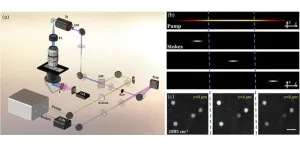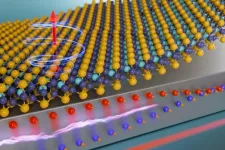(Press-News.org) Cedars-Sinai investigators have discovered why some injured kidneys heal while others develop scarring that can lead to kidney failure. Their findings, detailed in a paper published in the peer-reviewed journal Science, could lead to the development of noninvasive tests to detect kidney scarring and, eventually, new therapies to reverse the condition.
“The key to this discovery was our ability to directly compare injured kidney cells that successfully regenerated with those that did not,” said Sanjeev Kumar, MD, PhD, a nephrologist-scientist in the Board of Governors Regenerative Medicine Institute and the Department of Medicine at Cedars-Sinai and senior author of the study. “Injured cells activate a protein called SOX9 to regenerate themselves. When they have healed, the cells silence this protein. Cells that aren’t able to regenerate leave SOX9 active, and this leads to a type of scarring called fibrosis. But when we deactivate SOX9 in a timely fashion, the scarring literally goes away.”
The kidneys, two fist-sized organs that filter waste from the blood, can be injured by diabetes and high blood pressure, serious infections such as COVID-19, and overuse of antibiotics and non-steroidal anti-inflammatory pain medications, said Kumar, who is also part of the Department of Biomedical Sciences at Cedars-Sinai.
The SOX9 protein plays a major role in organ development but is not active in healthy adult kidneys. In previous work at another institution, Kumar and team found that when kidneys are injured, the surviving cells reactivate SOX9 as part of the healing process.
In this study, Kumar and fellow investigators studied kidney damage in laboratory mice. They labeled individual cells at the point of injury, then followed how the cells’ progeny evolved over time.
“At Day 10, some cells’ descendants were fully healed while others were not,” Kumar said. “The cell lineage that healed had switched off SOX9 expression, while the unhealed lineage, in a continuing attempt to fully regenerate, maintained SOX9 activity. It’s like a sensor that switches on when cells want to regenerate, and off when they are restored, and we are the first to identify this.”
Further, investigators discovered that cells that were unable to regenerate began recruiting proteins called Wnts, another key player in organ development. Over time, this accumulation of Wnts triggered scarring. And they found that deactivating SOX9 a week after injury promoted kidney recovery.
Investigators observed the same process in patient databases from collaborating institutions in Switzerland and Belgium.
“We could see that by Day 7, human patients with transplanted kidneys that were slow to begin working also activated SOX9,” Kumar said. “And in our collaborators’ database, we were able to distinguish that patients who had sustained SOX9 activation had lower kidney function and more scarring than those who did not. Human kidneys with cells that maintained SOX9 were also enriched with Wnts and showed increased fibrosis.”
These discoveries provide targets for drug development, as well as for noninvasive biomarker discovery permitting diagnosis of kidney fibrosis through the urine, Kumar said. Currently, the only available test for kidney fibrosis is a biopsy, which carries many risks.
“Elucidating the mechanisms of scarless healing versus fibrosis has eluded investigators for decades and has implications beyond the kidney, including for certain cancers,” said Paul Noble, MD, chair of the Department of Medicine and director of the Women’s Guild Lung Institute at Cedars-Sinai and a co-author of the study.
The findings could also lead to new treatment options for patients, said Clive Svendsen, PhD, executive director of the Board of Governors Regenerative Medicine Institute at Cedars-Sinai and a co-author of the study.
“These findings help us understand for the first time how the kidney’s response to injury sometimes leads to fibrosis,” Svendsen said. “Future work along these lines could also advance our understanding of fibrosis in the heart, lungs and liver.”
Funding: This work was supported by the National Institute of Diabetes and Digestive and Kidney Diseases of the National Institutes of Health grant number R01 DK118265, American Heart Association award number 18CDA34110416, a John Merrill Transplant Scholar Grant from the American Society of Nephrology, a UCLA CTSI Catalyst Award, a One Legacy Foundation grant, Department of Defense grant numbers DoD CDMRP and KC200178, Swiss National Foundation grant number Sinergia CRSII5_202302, and by the Balli and Gianella foundations.
END
New Cedars-Sinai study pinpoints why some injured kidneys do not heal
Investigators have discovered a sensor of kidney healing, opening the door to development of new therapies to reverse kidney fibrosis
2024-02-22
ELSE PRESS RELEASES FROM THIS DATE:
Moving “beyond Mendel” in genetics education can reduce racism, new study suggests
2024-02-22
Data from a series of randomized trials in the United States suggests that if teachers move genetics instruction toward more complex genomics concepts, they can help students have a more scientifically accurate understanding of race. This can protect students from believing in unscientific notions of genetic essentialism, including the idea that inequality is genetic. People who believe in genetic essentialism believe – among other ideas – that most racial differences are determined by genes. Essentialist ...
Uncovered with JWST: A neutron star in the remnant of Supernova 1987A
2024-02-22
Astronomers using the James Webb Space Telescope (JWST) have found conclusive evidence of a neutron star in the remnant of Supernova 1987A, the only supernova visible to the naked eye in the last 400 years and the most studied supernova in history. Although Supernova 1987A has been observed for more than three decades, scientists have not seen the compact object expected to have been produced during the explosion. Some indirect evidence had suggested that the supernova produced a neutron star, but a black hole wasn’t ruled ...
Chemistry and albedo feedbacks offset forestation’s net climate benefits
2024-02-22
Roughly a third of the climate cooling that forests achieve by removing carbon dioxide (CO2) from the atmosphere is offset through changes to atmospheric composition and decreased surface reflectivity, researchers report. The findings suggest that the benefits of wide-scale forestation efforts may be overestimated and do not represent a single solution for addressing climate change. They also highlight the urgency of simultaneously focusing on emissions reductions. Planting trees has been widely promoted as a nature-based solution to remove anthropogenic CO2 from the atmosphere to help mitigate ...
Snakes do it faster, better: How a group of scaly, legless lizards hit the evolutionary jackpot
2024-02-22
More than 100 million years ago, the ancestors of the first snakes were small lizards that lived alongside other small, nondescript lizards in the shadow of the dinosaurs.
Then, in a burst of innovation in form and function, the ancestors of snakes evolved legless bodies that could slither across the ground, highly sophisticated chemical detection systems to find and track prey, and flexible skulls that enabled them to swallow large animals.
Those changes set the stage for the spectacular diversification of snakes over the past 66 million years, allowing them to quickly exploit new opportunities ...
Side effects of wide scale forestation could reduce carbon removal benefits by up to a third
2024-02-22
The side effects of large-scale forestation initiatives could reduce the CO2 removal benefits by up to a third
Researchers at the University of Sheffield used computer models, which simulate the land, ocean and atmosphere, to investigate the impact of forestation under future climate scenarios
While forestation increases atmospheric CO2 removal, it also changes atmospheric composition and darkens the land surface, reducing its potential to tackle climate change
Combining forestation with other climate mitigation ...
Yale chemists synthesize unique anticancer molecules using novel approach
2024-02-22
New Haven, Conn. — Nearly 30 years ago, scientists discovered a unique class of anticancer molecules in a family of bryozoans, a phylum of marine invertebrates found in tropical waters.
The chemical structures of these molecules, which consist of a dense, highly complex knot of oxidized rings and nitrogen atoms, has attracted the interest of organic chemists worldwide, who aimed to recreate these structures from scratch in the laboratory. However, despite considerable effort, it has remained an elusive task. Until now, that is.
A team of Yale chemists, writing in the journal Science, ...
Maynooth University partners in study published in Science that finds evidence of elusive neutron star
2024-02-22
A new study, published in Science and co-authored by Dr Patrick Kavanagh of Maynooth University’s Department of Experimental Physics in Ireland, has provided the first conclusive evidence for the presence of the elusive neutron star produced in the supernova SN 1987A.
Supernovae are the spectacular end result of the collapse of stars more massive than eight to ten times the mass of the sun. Besides being the main sources of chemical elements such as the carbon, oxygen, silicon, and iron that make life possible, they are also responsible for creating the ...
James Webb telescope detects traces of neutron star in iconic supernova
2024-02-22
Scientists can finally show that a neutron star formed from our most well-studied supernova, SN 1987A. The breakthrough was made possible thanks to the James Webb telescope.
Supernovae are the spectacular end result of the collapse of stars more massive than 8-10 times the mass of the sun. Besides being the main sources of chemical elements such as carbon, oxygen, silicon, and iron that make life possible, they are also responsible for creating the most exotic objects in the universe, neutron stars and black holes.
In 1987, supernova 1987A (SN 1987A) ...
Enhanced 3D chemical imaging with phase-modulation
2024-02-22
Understanding complex biological and biomedical systems is greatly aided by 3D imaging, which provides much more detailed information than traditional two-dimensional methods. However, live cell and tissue imaging remain challenging due to factors like limited imaging speed and significant scattering in turbid environments.
In this context, multimodal microscopy techniques are notable. Specifically, nonlinear techniques like CRS (coherent Raman scattering) use optical vibrational spectroscopy, providing precise chemical imaging in tissues and cells in a label-free way. Furthermore, stimulated Raman scattering (SRS) ...
Researchers harness 2D magnetic materials for energy-efficient computing
2024-02-22
CAMBRIDGE, MA — Experimental computer memories and processors built from magnetic materials use far less energy than traditional silicon-based devices. Two-dimensional magnetic materials, composed of layers that are only a few atoms thick, have incredible properties that could allow magnetic-based devices to achieve unprecedented speed, efficiency, and scalability.
While many hurdles must be overcome until these so-called van der Waals magnetic materials can be integrated into functioning computers, MIT researchers took an important step in this direction by demonstrating precise control of a van der ...
LAST 30 PRESS RELEASES:
American Meteorological Society announces Rick Spinrad as 2026 President-Elect
Biomass-based carbon capture spotlighted in newly released global climate webinar recording
Illuminating invisible nano pollutants: advanced bioimaging tracks the full journey of emerging nanoscale contaminants in living systems
How does age affect recovery from spinal cord injury?
Novel AI tool offers prognosis for patients with head and neck cancer
Fathers’ microplastic exposure tied to their children’s metabolic problems
Research validates laboratory model for studying high-grade serous ovarian cancer
SIR 2026 delivers transformative breakthroughs in minimally invasive medicine to improve patient care
Stem Cell Reports most downloaded papers of 2025 highlight the breadth and impact of stem cell research
Oxford-led study estimates NHS spends around 3% of its primary and secondary care budget on the health impacts of heat and cold in England
A researcher’s long quest leads to a smart composite breakthrough
Urban wild bees act as “microbial sensors” of city health.
New study finds where you live affects recovery after a hip fracture
Forecasting the impact of fully automated vehicle adoption on US road traffic injuries
Alcohol-related hospitalizations from 2016 to 2022
Semaglutide and hospitalizations in patients with obesity and established cardiovascular disease
Researchers ‘listen in’ to embryo-mother interactions during implantation using a culture system replicating the womb lining
How changing your diet could help save the world
How to make AI truly scalable and reliable for real-time traffic assignment?
Beyond fragmented markets: A new framework for efficient and stable ride-pooling
Can shape priors make road perception more reliable for autonomous driving?
AI tracks nearly 100 years of aging research, revealing key trends and gaps
Innovative techniques enable Italy’s first imaging of individual trapped atoms
KIER successfully develops Korea-made “calibration thermoelectric module” for measuring thermoelectric device performance
Diversifying US Midwest farming for stability and resilience
Emphasizing immigrants’ deservingness shifts attitudes
Japanese eels, climate change, and river temperature
Pusan National University researchers discover faster, smarter heat treatment for lightweight magnesium metals
China’s 2024 Gastroenterology Report: marked progress in endoscopy quality and disease management
Pusan National University researchers uncover scalable method for ultrahigh-resolution quantum dot displays
[Press-News.org] New Cedars-Sinai study pinpoints why some injured kidneys do not healInvestigators have discovered a sensor of kidney healing, opening the door to development of new therapies to reverse kidney fibrosis



